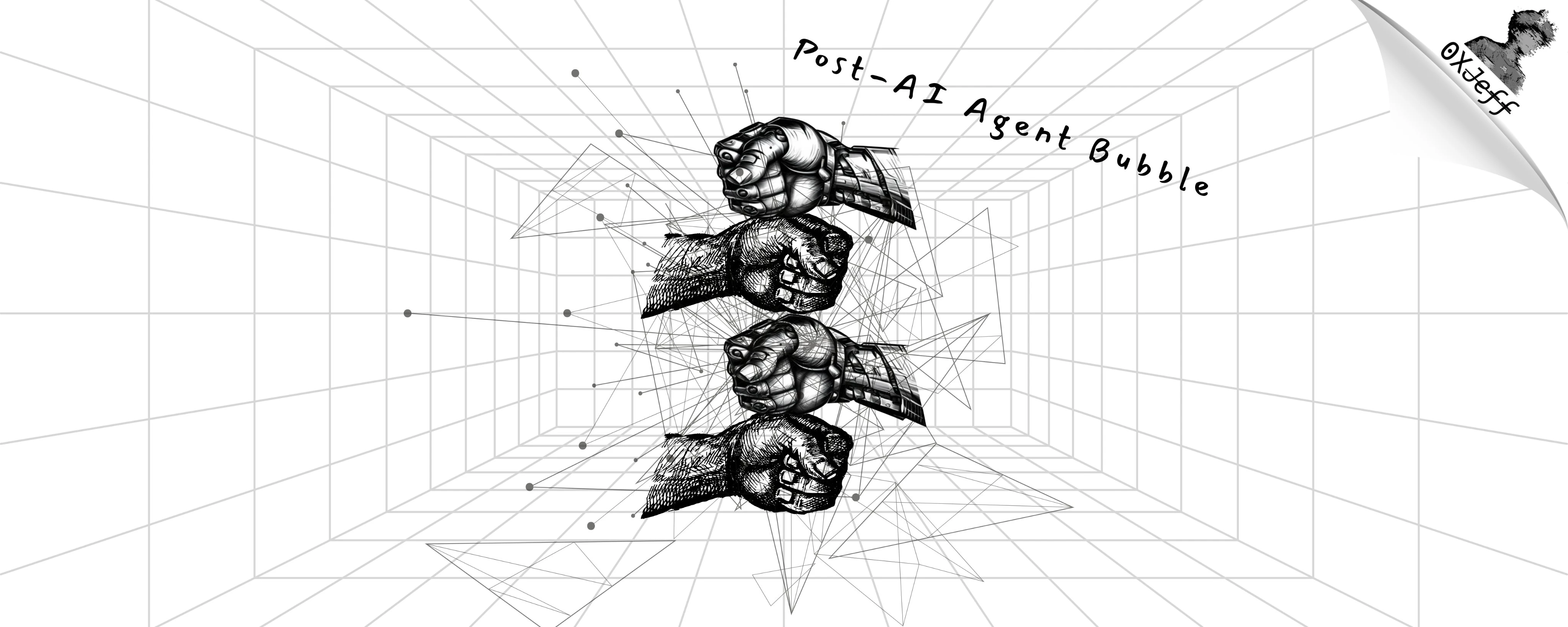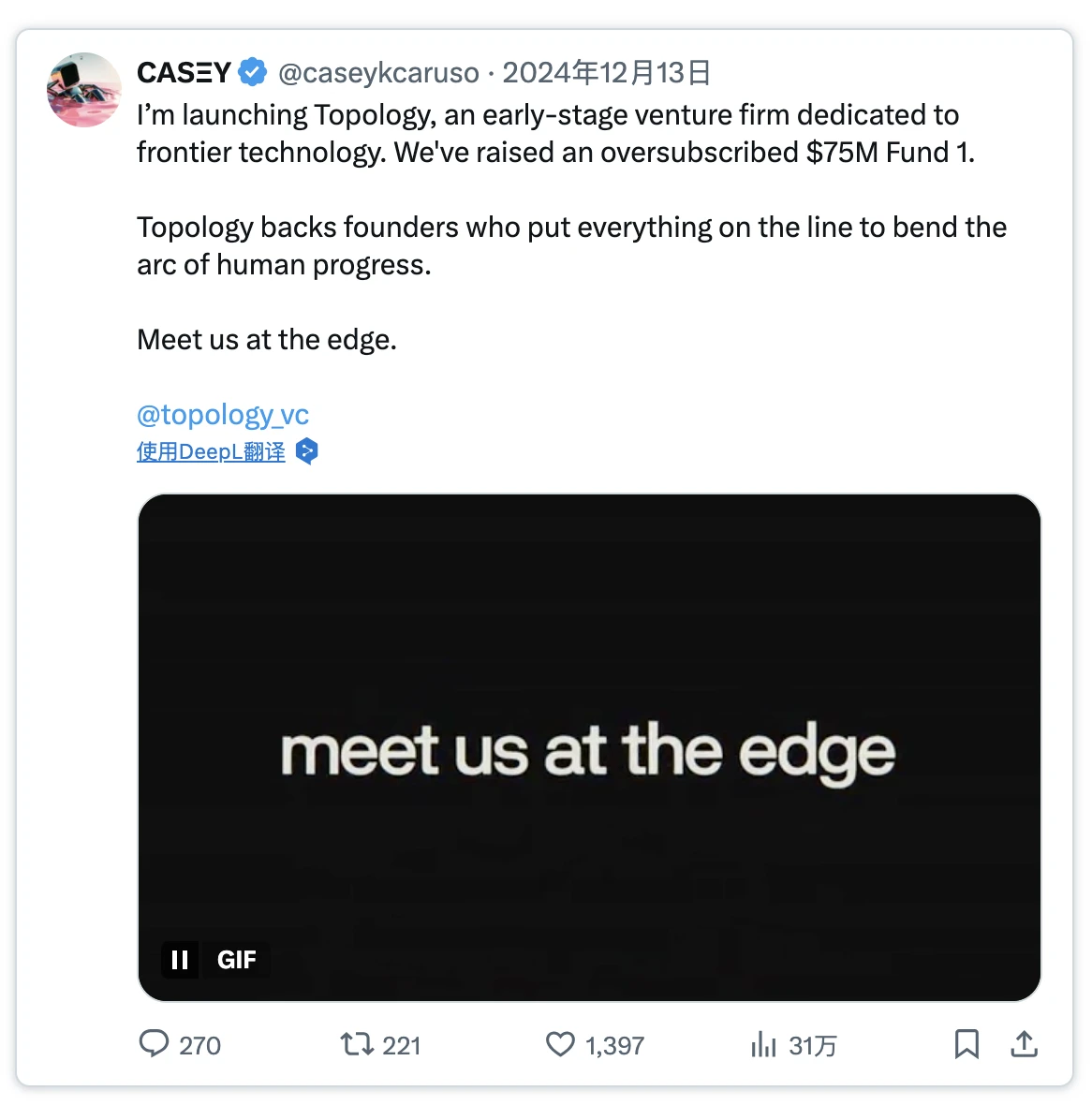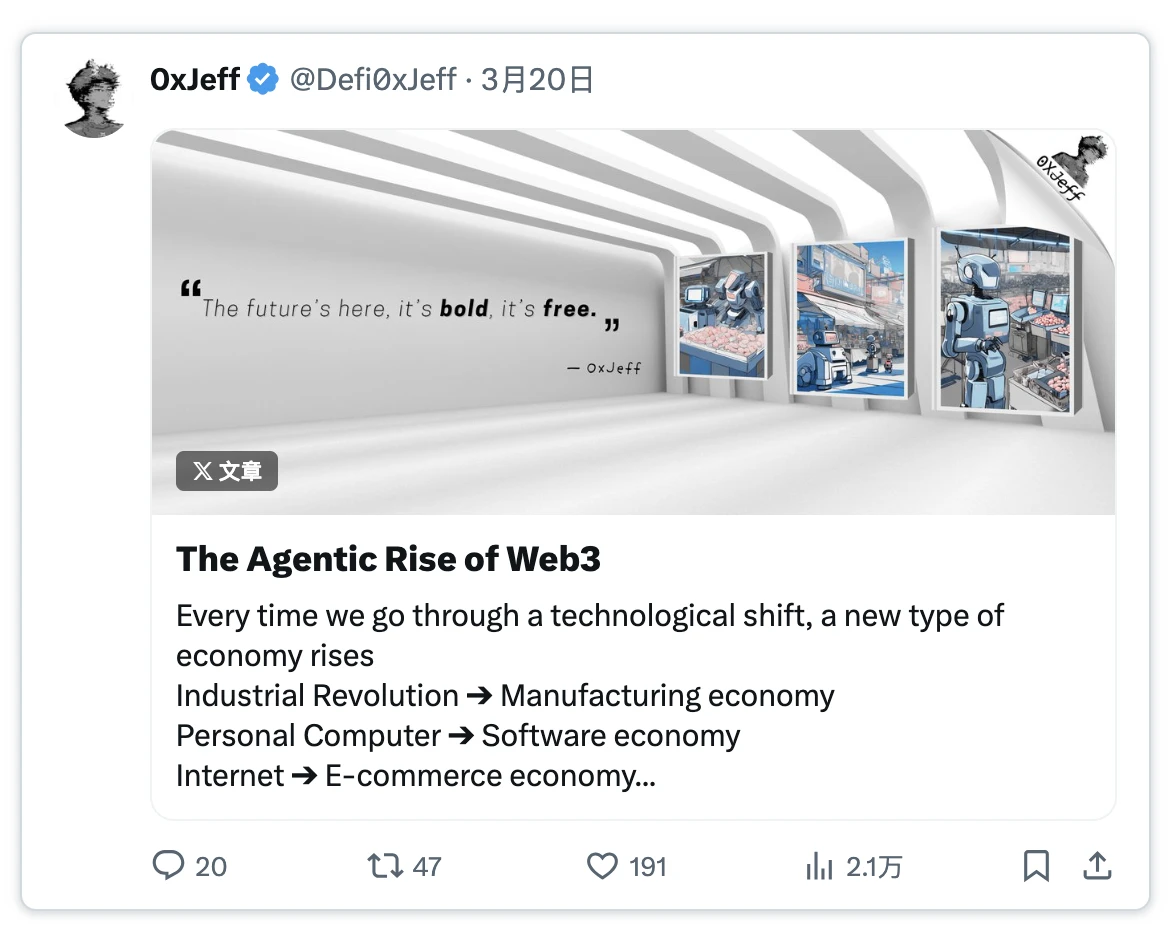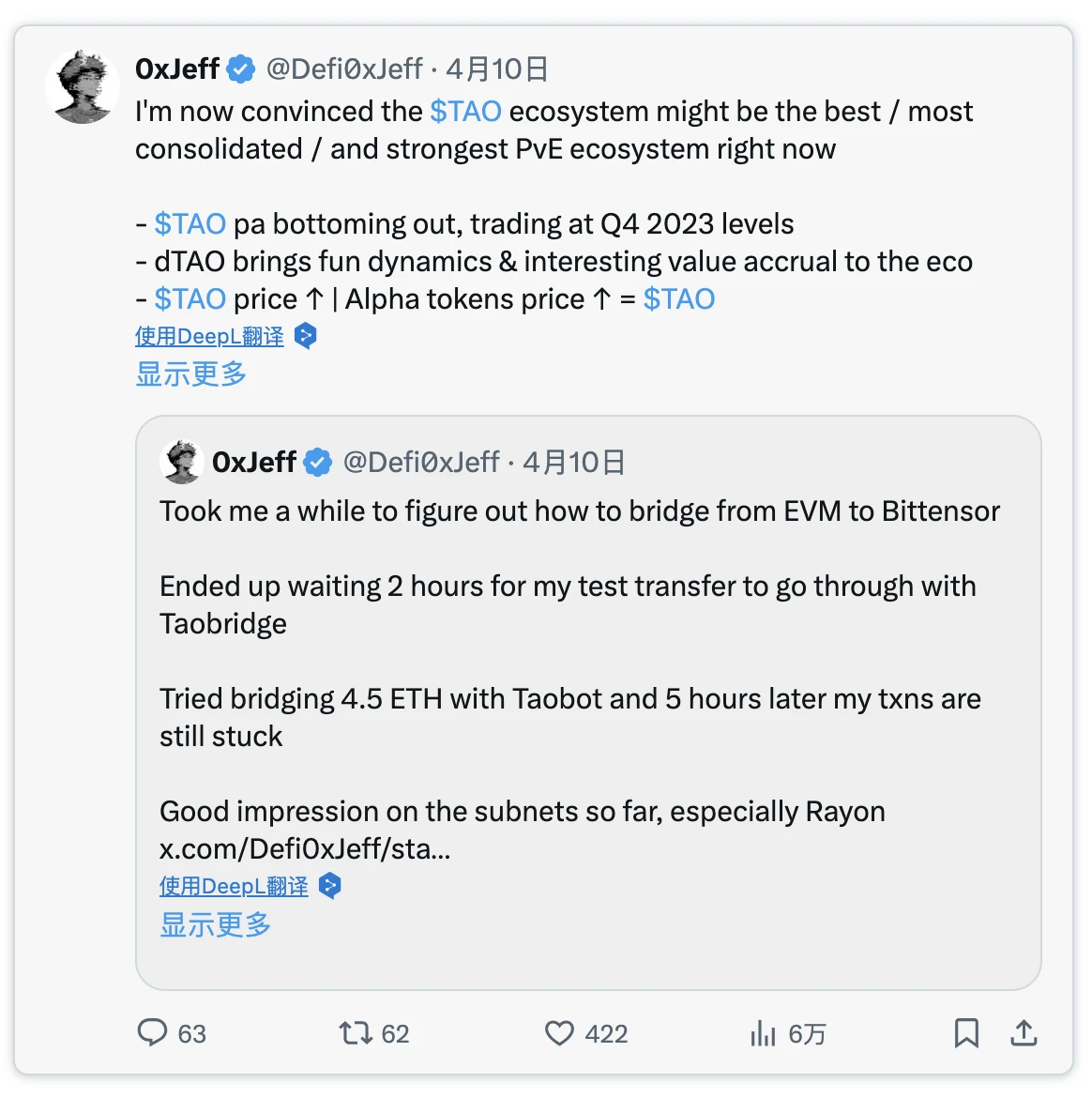Original title: Post-AI Agent Bubble: Wheres the Real Value in Web3 AI?
Original author: 0x Jeff ( @Defi 0x Jeff )
Compiled by: Ethan ( @ethanzhang_web3 )

Brief Overview:
The total market value of AI agents grew from 0 to over $20 billion in a few months, and then quickly collapsed. But the field is gradually maturing. Infrastructure, decentralized AI, and real practicality are gradually taking over. How will the next wave of developments shape the future, and why should we pay attention?
In the fourth quarter of last year, we saw one of the fastest growing sectors, “AI agents”, grow from zero to over $20 billion in just a few months – from some fun, charismatic, entertaining “agents” to financial agents that promise to change the world and make you rich overnight through trading and investing. And…it’s not just agents that make you rich, investment DAOs have also emerged…human (or agent) DAOs (3, 3) investing in other agents.
From Hype to Infrastructure: The Evolution of Web3 AI Agents
We all understand that in an emerging space (and in the context of Web2 AI, Trump getting elected and supporting new catalysts like crypto and AI), people don’t care about fundamentals. Anything that can make noise and look hyped and cool can almost quickly reach a market cap of over $100 million.
@virtuals_io has become an ecosystem that captures the market, captures the markets attention, tells good stories, and creates the best narratives. This has attracted a large number of creators to publish content and launch projects on Virtuals, while also attracting the attention of retail investors to capitalize on hype.
Then @elizaOS came along and took a different approach - open source AI, allowing any developer with a shovel to dig for gold. A huge viral effect formed around this idea, and adoption grew rapidly, with a dramatic increase in stars and forks on GitHub (and these numbers continue to grow).
Virtuals has grown to over $5 billion in valuation, with Eliza accounting for about half of that at its peak, and a few other interesting proxies hitting 8-9 figure valuations, such as AIXBT hitting $1 billion. Of course, things are very different now, with newly launched, decent performing proxies averaging between $3-10 million. Old, decent performing proxies are averaging between $10-50 million. The valuation ceiling has been compressed, with the overall market cap shrinking from $20 billion to the $4-6 billion range.
Infrastructure acceleration and rapid advancement of Web2
The market is now starting to focus on “pure fundamentals”, with people paying more attention to infrastructure, decentralized AI, and especially AI models in Web2, which continue to accelerate at an alarming rate—Meta’s Llama, OpenAI’s GPT, Grok, DeepSeek, Ali Qwen, etc. release new improvements and more optimized models every month. ChatGPT’s image generation model quickly triggered a “Ghibli-ization” trend after its release.
On top of all this, the consumer layer of Web2 is growing much faster than ever before due to the increased power of AI models - things that were previously impossible are now possible. Tools like Lovable, Bolt, Cursor, and Windsurf enable developers to launch more products faster. Agent workflows and AI agents are everywhere. The barrier to entry is lowered and the switching cost for users is almost zero - if you hate an application, you can easily find a more competitive service or product with a better interface and user experience.
Data ownership awakening: the call for decentralized AI
At the same time, many people are starting to wonder: “Since so many agent applications are using centralized technology, who owns my data? Where does my data go? If I discuss something private with the AI, will it remain confidential or will it leak out?” This question is particularly important, especially because OpenAI’s recent update mentioned that ChatGPT can now reference your past chats to provide more personalized responses.

Well… this all sounds cool and will likely usher in a wave of personalized AI agents like co-pilots, personal secretaries, therapists, companions, etc. But you can imagine what the consequences will be when someone else owns or controls your data.
Decentralized AI (DeAI): The power that leads the future
One of the predictions I made last year was that decentralized AI would come to the fore by the second quarter of 2025, with infrastructure enhancing confidentiality, transparency, verifiability, and data ownership, leading to greater adoption and traction.
This trend can be divided into three main parts, many of which intersect or interweave with each other:
Web2 AI venture capital trends (YC launches vertical agency, a16z lays out future consumer trends, Perplexity launches AI fund)

Web3 AI venture capital trends (DeAI infrastructure investment, distributed training, inference networks, etc.)

Web3 AI Retail Trends (AI Agent Ecosystem, Consumer Agent, AI Consumer Applications)

Web2 and Web3 AI: Two Worlds Collide
For Web2 , since the total address market (TAM) is much larger than Web3, that is, many businesses are seeking to transform and optimize their business through AI, improve workflows, so as to generate more leads, more conversions, higher sales, retain more customers, reduce administrative costs, and operate in a more efficient manner. Therefore, many businesses seek solutions that can solve their specific pain points.
This need for optimization has attracted many young entrepreneurs to look for better ways to introduce AI agents into workflows. Compared to traditional SaaS, AI agents provide solutions that can save a lot of money or generate more leads. This allows agent startups to charge higher subscription fees for their use (which is why we see many startups reaching 7-8 figures in annual revenue within a few months).
For Web3 venture capital , the trends here are completely different because blockchain provides the perfect infrastructure layer for DeAI, such as: verifiable/immutable transaction records, trustless environment, decentralized computing, trust-minimized AI inference and training (sorry for the jargon, but you should get the point).
In short, the future is about people understanding how their data is processed, understanding the thought process of AI, owning their own data, owning their own models and use cases, and being motivated to share (without censorship), etc. Web3 venture capital is already investing in these future trends.
The AI Agent Boom in Retail: More Than Just Entertainment
For the Web3 retail market, DeAI is very difficult to understand because it requires you to learn a lot of terms and understand the key points (sometimes it feels like an alien language). That’s why retail market users prefer the easiest to understand things - such as Web3 AI agents starting with conversational bots, which are funny and can do entertaining content.
As the retail market continued to move deeper into the industry, they gradually realized that these basic skills of just chatting and analyzing were not enough to create sustainable value for users. This realization (combined with the poor market environment) led to market consolidation, and useless agents gradually disappeared, while useful agents still survived (although their valuations were greatly reduced).
People are beginning to realize that AI products must have a core practical use case. This realization prompted the team to either develop real AI products or cooperate with real AI companies with real technology, such as @AlloraNetwork and @opentensor (Bittensor).
The benefits of this shift are twofold:
(i) It has given people more understanding about infrastructure.
(ii) It provides real use cases for AI agents, allowing them to demonstrate their value to the community.
Before: Agents with basic skills/use cases (chat, analytics, etc.)
After: Agents with advanced practical skills (such as AI-driven betting, trading, liquidity provision, farming, etc.)
Agents like @AskBillyBets and @thedkingdao became ideal agents, demonstrating Bittensor subnets and bringing cool technology into the mainstream.
Bittensor Ecosystem: New Investment Opportunities in Decentralized AI
I think one of the interesting things about the Bittensor ecosystem is that it is an ecosystem full of decentralized AI that anyone can invest in. Today, most decentralized AI projects are limited to VC or strategic investors behind closed doors because they are still in the early stages and many projects have not yet issued tokens.
But Bittensor allows anyone to stake their $TAO to the subnet they want to support, thereby converting it into the subnet’s alpha token (directly participating in the DeAI project).
While I have publicly expressed my disappointment with the bridge and trading experience, the technology, product, and atmosphere at Bittensor are outstanding, especially the team at @rayon_labs .

I like Rayon Labs because they have done a lot of consumer-friendly work in optimizing the UI/UX. Given the nature of dTAO - the market determines the emissions of each subnet and the pricing of the subnet - it becomes particularly important for each subnet to build a product that is easy to understand and comprehend.
Rayon has a lot of cool subnetworks (the coolest of which is probably Gradients, an AutoML platform that makes it easy to train models on the platform), but even cooler is their latest flagship product, the Squad AI agent platform, which allows users to create agents by dragging and dropping boxes (similar to how Figma creates AI agents).

Conclusion
I’m still in the early stages of learning more about Bittensor and will publish a dedicated article later to share what I found interesting and show how to seize opportunities from it.
If you want to know other trends and changes in the market, please refer to the article From conversational assistants to intelligent execution, how will AI Agent break through next? .










